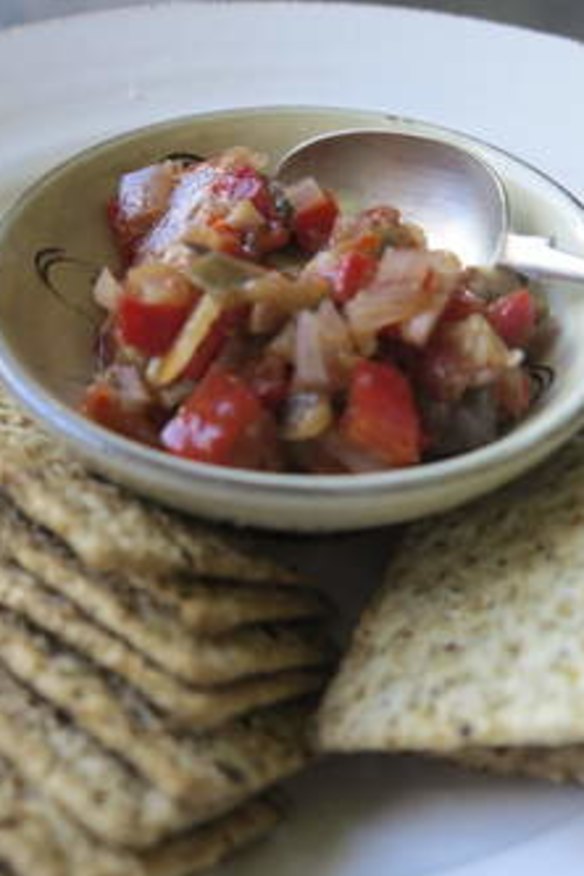A Sicilian delight

The hot weather meant very sweet tomatoes, capsicums and eggplant in the garden this year, which makes this the perfect season for caponata. You also need celery, capers, green olives and the sweet-sour caramelised sauce agrodolce.
There seem to be many versions of caponata, and I am sure there are many arguments over which is the true one. This is how I make mine, and some ways you can adjust it.
Some traditional recipes use tomato paste rather than chopped tomatoes, but I'm using fresh tomatoes, as they are delicious and in my garden now.
Some versions add garlic to the caponata, but I would rather rub the garlic clove on to some toasted baguette when serving the caponata as a snack on toast.
Others add chocolate, pinenuts and herbs, and many recipes include raisins or currants. I like the idea of adding dried fruit if I am serving the caponata as a relish with roast lamb or as a comfort food with creamy mashed potato and grilled sausages.
Caponata can be served hot with baked or poached eggs, or as a pizza base - in which case you could add sliced chilli to the caponata. It's also delicious as a side served with grilled fish.
The second eggplant recipe on this page is from the new Silver Spoon Kitchen.
Robbie Howard is co-owner of Lynwood Preserves.
Caponata
1-2 eggplants
½ cup capers, salted or in brine
1 red and 1 yellow capsicum
2 onions, finely diced
2-3 celery stalks (the tender pale-green stalks from the centre)
2 ripe tomatoes, peeled and finely chopped
about 1½ cups extra virgin olive oil, the quantity depends on how much the vegetables absorb
¾ cup stoned green olives, chopped
2 tbsp sugar
½ cup white wine vinegar
salt and freshly ground pepper
Cut the eggplant into cubes about 2cm x 2cm (do not peel it). Place them in some salted water for about half an hour. This will keep the eggplant white and means it will absorb less oil while cooking.
If the capers are salted rinse them well. Dice the capsicum into the same size dice as the eggplant. Chop the onion finely. Slice the celery sticks and the green celery leaves finely. Peel and seed the tomatoes and finely dice them.
Drain the eggplant and squeeze in a clean tea towel to remove as much water as possible.
Work in batches to fry the vegetables, keeping them in a single layer, being careful not to crowd them. Heat a large frypan over medium heat with three-quarters of a cup of the oil. Add the eggplant cubes and saute until soft and golden, 10 to 12 minutes. Place the drained eggplants into a large bowl and set aside.
Add some extra oil and fry the capsicum until wilted and beginning to turn brown, 10 to 12 minutes. Drain the capsicum and add to the eggplant.
Add a little more oil to the pan and saute the celery gently; add to the eggplant and capsicum.
Add a little more oil again and saute the onion. Add the tomatoes to the onions, and allow their juice to evaporate. Add the capers and olives. Allow these ingredients to cook gently for one or two minutes. Empty the contents of the frypan into the bowl with the other cooked vegetables.
For the agrodolce sauce, add the sugar to the frypan coated with the caramelised flavours, and let it melt and bubble. Add the vinegar and evaporate. Incorporate all the vegetables into the frypan with the agrodolce sauce.
Add the pepper and adjust the salt, being careful if you used salted capers. Taste and adjust the sweet-sour flavour, adding more sugar or vinegar if necessary. Gently toss all the ingredients over low heat to blend flavours. Store in the fridge until ready to use, and bring to room temperature before serving.
The best recipes from Australia's leading chefs straight to your inbox.
Sign up